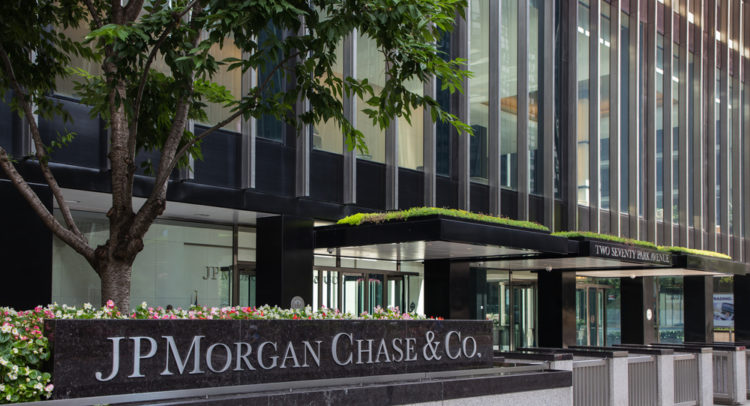JPMorgan Chase (JPM) is at a turning point, with tailwinds from the elevated market activity of 2020-2021 fading. At the same time, FED rate hikes are going to be realized later this year. That said, I think investors can expect a low double digit rate of return going forward. I think selling at the money options premium looks likely to be the best way to position in the stock.
For risk-averse investors looking for the short-term and focused on the current yield, the 4.5% preferred shares offer a compelling opportunity. However, I would not hold them over the long-term, given the growth prospects of the company and the decent return potential of the common stock.
JPMorgan Chase operates in five key divisions, namely Consumer & Community Banking (CCB) at about 40.4% of Q4 2021 revenue, Corporate & Investment Bank (CIB) at 38% of Q4 2021 revenue, Commercial Banking (CB) at 8.6% of Q4 2021 revenue, Asset & Wealth Management (AWM) at 14.7% of Q4 2021 revenue and Corporate at negative 1.8% of Q4 2021 revenue.
Q4 Operational Overview
JPMorgan Chase delivered a solid Return on Tangible Common Equity (ROTCE) of 19% in Q4 2021. The figure is 17% if adjusted for the $1.8B net credit reserve release. However, the 17% ROTCE was below the 18% achieved for the whole of 2021 (adjusted for net credit releases). This reflects normalization in capital markets activity in the fourth quarter, which I expect to continue into 2022.
Case in point, Markets revenue was $5.3B, down 11% year-over-year, but still up 7% compared to 2019. Asset & Wealth Management remains a bright spot, with a 16% year-over-year increase in revenue to $4.5B. Overall, management expects a further moderation in ROTCE to below 17% in 2022, to be followed by a drift to 17% over the medium term.
On the conference call and in the presentation slides, management was keen to point out that although a normalization of more volatile performance areas is to be expected, JPMorgan Chase has accomplished several milestones in more stable business lines. For example, it is the first bank to have branches in all 48 contiguous states, and has been gaining market share in several key areas.
Another thing to note from the conference call is that going forward, the current assumption is that JPMorgan Chase will have to operate at a higher CET1 in the 4.5% Global Systemically Important Banks(G-SIBs) bucket, with a 1% change in CET1 capital impacting ROTCE by about 150 basis points.
Medium-Term Return Potential
JPMorgan Chase has shown consistent performance in recent years. An elevated level of capital markets activity and provision reversals in 2021 have led to a stellar ROTCE of 23% in 2021.
Adjusting the 23% ROTCE for provision releases takes down the ROTCE to 18%. I expect capital markets activity and the deal-making boom of 2020-2021 to moderate going forward. Thus, I think a 16% ROTCE can be achieved over the medium to long term.
In good years such as 2021, an 18% ROTCE seems within reach. In moderate recessionary years, a lower range of 14% ROTCE should be built into the assumptions. Taking the tangible book value per share (TBV) of $71.53 as of Q4 2021 and applying these assumptions leads us to these medium term return scenarios:
| Scenario | ROTCE | Return on TBV($71.53) |
| Optimistic | 18.00% | 12.88$ |
| Realistic | 16.00% | 11.44$ |
| Pessimistic | 14.00% | 10.01$ |
Keep in mind that while the recession in 2020 was severe by historical standards, government support was also unusually high. This resulted in a better-than-anticipated outcome for banks in general. Needless to say, a 2020-style recession with more normal levels of government support will push the ROTCE well below 14%.
How to Position in the Shares
All in all, assuming a 60% payout, investors can expect a dividend + buyback yield of 3.8% to 4.9% at current prices, which, when coupled with a solid earnings growth of around 6%, makes for a low double digit return potential over the medium term.
If you are in just for the current yield, the 4.5% preferred shares offer a solid short-term alternative with a lower level of risk. Selling at the money puts looks like a solid play as well, which should yield around 12%. I think this looks like the best medium term play, as the stock is trading well above tangible book and the valuation is based on high recurring and future earnings. Of course, if JPMorgan Chase were to go for a more substantial payout policy of around 90%, the balance would shift from earnings growth to current yield.
Shifting Tailwinds
With capital markets and deal making activity cooling off in 2022 and beyond, the main tailwind for JPMorgan Chase should shift from the trading rooms to the Federal Reserve. The last Fed rate raising cycle started in December 2015 and ended in December 2018. Afterwards, the Fed was on pause for H1 of 2019 before resuming rate cuts in H2 2019.
Since it takes time for Fed hikes to show up in ROTCE I think H1 2019 offers a glimpse at what JPMorgan Chase profitability may look like after the Fed is done hiking rates. Indeed, the ROTCE in Q1 of 2019 was 19%. In Q2 of 2019 it stood at 20%, close to the exceptionally high numbers we have seen in 2021. For comparison, back in 2015 the ROTCE was 14-15% in Q1-Q3, just before the liftoff in rates. Overall, I would expect the ROTCE to dip in 2022 before improving in 2023 on the back of the full run-rate effect of higher rates.
Wall Street’s Take
From Wall Street analysts, JPMorgan Chase earns a Moderate Buy rating, based on nine Buy ratings, four Hold ratings and 1 Sell rating. Additionally, the average price target of $185.79 puts the upside potential at 17.7%.

Investor Takeaway
JPMorgan Chase commands a premium valuation and is less exposed to rising rates than other big banks. I think the recent pullback in the shares creates a good entry point for income-generating option-selling strategies with a neutral bias.
Shorter-term investors looking for current yield may want to opt for the 4.5% preferred shares. Any uptick in the price can be used to take profits, as anticipated Fed rate hikes will take time to show up in the bank’s bottom line. This should give investors ample time to reposition in the shares.
Download the TipRanks mobile app now
To find good ideas for stocks trading at attractive valuations, visit TipRanks’ Best Stocks to Buy, a newly launched tool that unites all of TipRanks’ equity insights.
Read full Disclaimer & Disclosure
















